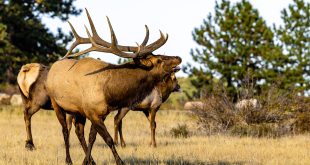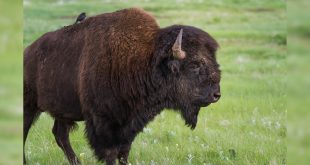Big Bucks For Big Bucks, Does and Fawns
Matthew Copeland
GREEN RIVER, Wyo.– The Muley Fanatic Foundation, a grassroots sportsmen’s and –women’s group based in southwest Wyoming, has pledged $1.3 million to solve one of the most vexing and persistent mysteries in wildlife science – the cause of West-wide mule deer population declines.
The Deer-Elk Ecology Research (D.E.E.R.) project – a collaborative venture of the Muley Fanatic Foundation, the University of Wyoming Cooperative Fish and Wildlife Research Unit, and the Wyoming Game and Fish Department – aims to learn exactly what factors are hurting mule deer numbers, which of those factors are having the largest impacts, and how they interact. At question are the relationships between interspecies competition, predation, drought, habitat alteration and other challenges believed to impact mule deer. Scientists will focus on certain deer behavioral clues – diet, migration patterns and seasonal habitat selection – to tease out those relationships and, hopefully, the roots of poor population performance and buck numbers.
In perhaps the most ambitious study ever of its kind, the five-year D.E.E.R project will use five kinds of high-tech tracking devices, satellite monitoring, cutting-edge laboratory analysis, 170 helicopter enabled animal captures and the dedicated services of a full-time PhD candidate.
“Conservation efforts are only as good as the information they’re based on,” said Muley Fanatic President Joshua Coursey, explaining his organization’s hefty investment. “It’s critically important that we in the hunting community support this cause. We’re asking for help from deer enthusiasts everywhere to stop the long slide.”
By focusing on the relationships between known and suspected limiting factors D.E.E.R. is building on existing science and taking an innovative new approach to an old question: Why are deer disappearing? Scientists have long known, for example, that certain types of vegetation benefit mule deer. And everyone knows that an oversized population of large predators can depress deer numbers. Yet management efforts geared at either variable alone, or any of the other usual suspects, have failed to halt the four decade long skid. So instead of reexamining one or more of the already thoroughly dissected individual components, D.E.E.R. seeks to learn how those components interact, and how management practices can be adapted to appropriately affect the entire system.
Mule deer love mountain mahogany. And we have effective habitat treatments for promoting mountain mahogany growth. It follows naturally than that those treatments would benefit deer populations right? Maybe say D.E.E.R. project scientists. In truth all we know is that such linear thinking has thus far proven inadequate to the problem. What if more mountain mahogany also attracts more elk, who in turn draw extra lions onto the deer parturition range, with a net result lower fawn survival? It’s an oversimplified and unlikely hypothetical, but it serves to demonstrate that in the world of wildlife management, A + B, doesn’t always equal C. Which variables are really driving the system? Scientists yet don’t know, and until they do game managers are shooting in the dark.
Also unlike conventional academic research, which is often conducted in relative isolation, the D.E.E.R. project will inform game management practices in real time, hopefully reversing alarming population trends more quickly. The UW Coop will maintain responsibility for the project’s scientific design, oversight and analysis. Wyoming Game and Fish will be intimately involved in fieldwork and data collection. “UW Coop Unit research often translates into specific on-the-ground wildlife management actions. That is certainly the case for this research project – it supports our current big game management priorities and will provide important findings that can be used assoon as they are available,” said WGFD Deputy Director John Kennedy. Muley Fanatic’s role as the funding arm will free up its two partners to focus on deer and data instead of dollars and cents.
The Greater Little Mountain Area of southwest Wyoming will serve as the project’s laboratory. Long cherished by Eastmans’ readers as a marquee public land trophy deer and elk hunting area, the landscape south of Rock Springs and Green River Wyoming has all of the suspected culprits – prolonged drought, habitat alteration, predation, and expanding elk populations. This suite of challenges, coupled with the composition of the landscape itself, makes the Little Mountain area an excellent stand-in for high-desert mule deer country West-wide. “What we learn about the challenges facing mule deer on Little Mountain will aid in understanding reasons behind our struggling mule deer populations in Wyoming and beyond, and what we can do to help them,” said UW Coop Unit Assistant Research Professor and D.E.E.R. project Principle Investigator Dr. Kevin Monteith.
The Muley Fanatic Foundation plans to meet the project’s $1.3 million price tag with raffles, memberships and other grassroots fundraising mechanisms. In an era where large scale conservation and research efforts are increasingly funded (and thus determined and defined) by massive institutional and family foundations, federal grant programs, corporate interests and a few well-heeled individuals, the Muley Fanatics are getting rank and file sportsmen and –women – the DIY crowd –back to the table. “As a mule deer fanatic and hunter, it is my job to step it up to make a difference within my living years and our future generations,” explains MFF cofounder and COO Joey Faigl. “Anyone who feels they are a true Muley Fanatic should do the same by supporting this project.”
Those interested in contributing can do so by joining the foundation or purchasing raffle entries at http://www.muleyfanatic.org .The first D.E.E.R. specific fundraising raffle is running now. $100 earns each entrant a chance at an offroad customized Ford F-150, wrapped in KUIU’s proprietary camouflage pattern. “The approach of a big ticket raffle is unique and will allow those who support mule deer to make a relatively small investment in our understanding of the pressures facing this herd” said UW Coop Unit Director Dr. Matthew Kaufman.
“It’s not about the raffle,” added Faigl. “It’s about the cause!”
About the Muley Fanatic Foundation
The Muley Fanatic Foundation focuses and informs the passion of deer hunters to make D.E.E.R., and other science and conservation projects possible. Founded in 2011, MFF has grown from a single collection of local enthusiasts to 7 regional chapters with 3827 members nationwide, in its first three years. In 2013 alone, the foundation invested $311,090 in on the ground projects in Wyoming and Colorado. Membership information and other opportunities to support MFFs efforts can be found at: http://www.muleyfanatic.org .
 Eastmans' Official Blog | Mule Deer, Antelope, Elk Hunting and Bowhunting Magazine | Eastmans' Hunting Journals
Eastmans' Official Blog | Mule Deer, Antelope, Elk Hunting and Bowhunting Magazine | Eastmans' Hunting Journals





Where is the Mule Deer Foundation on this? This seems like a great opportunity for collaboration. Glad to see that the Muley Fanatics are out there trying to figure out how to stop the decline in the mule deer population. Looks like I’ll have to join there group to lend my support.
What about the effect that cattle, over hunting, and increasing number of protected predators? In the area they are talking about there is a decline of mature bucks due to the fact that they put out way more permits then deer. I hear of rumors that the cattle associations, pressure the fish and game, to have more animals harvested so they can have plenty of grazing for their live stock. With bears and wolves moving into the same area, and a high number of mountain lion, it won’t be long and deer, elk and moose will be on the endangered species lists.